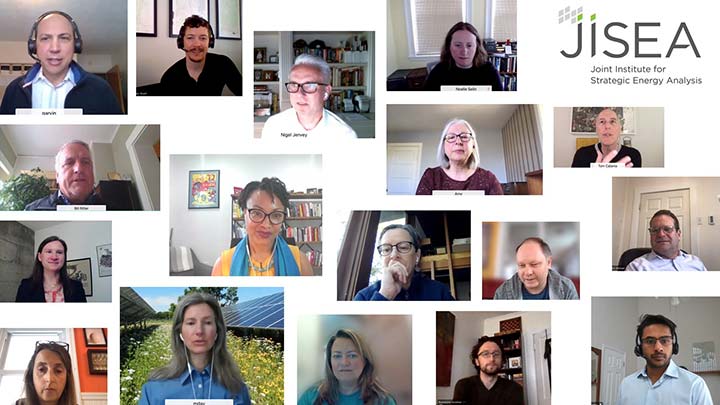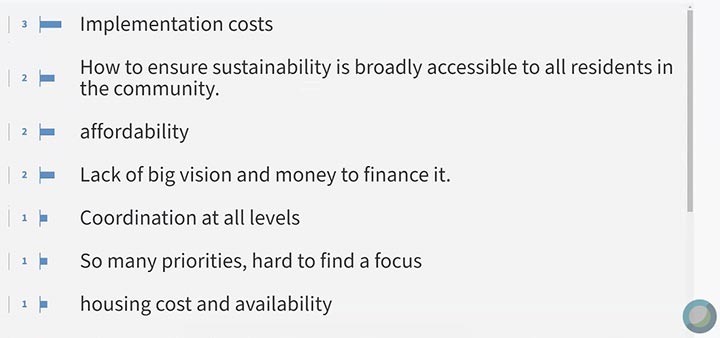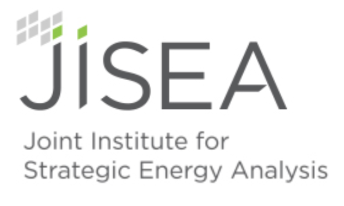2021 JISEA 11th Annual Virtual Meeting Connects, Engages, and Educates Attendees

Panelists and attendees discuss the clean energy transition in the JISEA annual meeting, which took place as one virtual session every morning over one week.
April 22, 2021—The Joint Institute for Strategic Energy Analysis (JISEA) hosted its 11th annual meeting April 12–16. Over the course of the week, JISEA moderators discussed emerging questions in the clean energy transition with esteemed panelists, including U.S. Deputy Director for Energy Justice Shalanda Baker.
True to the newly released 2021 Engage JISEA Annual Report, panelists and participants engaged in vibrant conversations, including polls and Q&As. "It was hard to stop the conversation at the end of each session," said Jill Engel-Cox, JISEA director. One attendee said during the Q&A of a session, "I had a whole series of questions because it was such a provocative talk." Links to presentations are available at the end of this story.
Day 1: Moving toward Clean Energy in Industry
Day one of the JISEA annual meeting focused on opportunities for industrial decarbonization. Globally, industry has more emissions than light-duty vehicles and aviation combined and is therefore critical to decarbonizing society. However, industrial decarbonization typically hasn't been a focus in government research and development.
The discussion was moderated by JISEA/National Renewable Energy Laboratory (NREL) analyst Mark Ruth, who leads research on the interface between electricity and industry. His work focuses on the opportunities for green hydrogen as a molecule to provide low-carbon heat, energy for transportation, long-duration electricity storage, and other services.
The session kicked off with a poll about whether companies or policy will drive industrial-sector sustainability; attendees voted for the former, whereas panelists thought policy would be the true driver of progress.
Tony Wood with the Grattan Institute in Australia presented on the country's opportunity to use hydrogen to produce low-carbon steel as well as the background on that decision. The shift could potentially add 25,000 Australian jobs. "It's a wonderful opportunity for Australia, but it won't be easy," Wood said. "To quote Bill Gates, we need to have the technology, policies, and markets."
Marlene Arens with the Fraunhofer Institute for Systems and Innovation Research (ISI) in Germany presented on commercial and emerging technologies to electrify the country's steel industry. Although there is corporate and government enthusiasm in green steel, green hydrogen is still expensive to produce, which remains a barrier.
Bringing in a large corporation's perspective, Kimberly Kupiecki with DuPont Water Solutions shared the company's multifaceted vision for sustainability and associated strategies to achieve it. "Sustainability is synonymous with innovation at DuPont," Kupiecki said. "With that lens, we provide the essential innovations for our customers to, for example, purify water, light-weight automobiles, and enable 5G networks, impacting the lives of billions."
Day 2: Mapping Relationships across Energy, Climate, and Air Pollution
Day 2 of the annual meeting explored interconnections across climate, air quality, atmospheric systems, and energy, which JISEA and NREL have been studying for over a decade.
Garvin Heath, JISEA analyst, served as the moderator. Heath was principal investigator for the first JISEA study on greenhouse gas emissions from shale gas production.
Presentations began with Nigel Jenvey from Gaffney, Cline & Associates, who discussed the state of decarbonization in the oil and gas industry—which accounts for 15% of emissions from the global energy sector—including the potential roles of green hydrogen and carbon capture, utilization, and storage technologies.
Noelle Selin from JISEA partner Massachusetts Institute of Technology discussed research from her group on the relationships among climate, renewable energy, and air quality. Methods included prospective and retrospective data analysis to study particulate matter and ozone concentrations associated with renewable deployment, including state-level cost and health impacts. Research found that cutting carbon has substantial air quality benefits overall. However, "Maximizing overall health benefit will not reduce disparities in all the states," Selin said. "Careful policy design is important."
Carolyn Snyder with the U.S. Environmental Protection Agency discussed the increasingly complex and interconnected impacts from a successful and inclusive clean energy transition as well as the analytical challenges to accurately capture and study those complexities.
Day 3: Bringing Equity into the Clean Energy Transition, Featuring Shalanda Baker
Day 3 featured keynote speaker and first-ever Deputy Director for Energy Justice Shalanda Baker. The conversation was moderated by Liz Doris, NREL's laboratory program manager for state, local, and tribal governments.
The session opened with a poll in which attendees voiced their opinion about the importance of equitable distribution in clean energy, voting that it is "somewhat important" or the "most important" item we should be thinking about. However, in a follow-on poll, the majority of attendees indicated they have only some or very little expertise in energy equity—indicating gaps in knowledge and setting a baseline for the conversation.
Doris and Baker discussed a shift that is taking place to include and consider diverse communities in energy research, development, demonstration, and deployment. "Historically, we've designed technology for privileged first adopters and expect it will trickle down, but that's not effective," Doris said. "If we want to get transformational—and our central mission at NREL is to transform the energy economy—we can't start with the people who can adopt."
"These technologies are being deployed in complex social systems, so we have to grapple with the social dynamics. It's long overdue," Baker said, who calls herself a troublemaker for discussing equity in climate change from the start of her career at a time when it wasn't popular. "We have to get out of our silos and have conversations with the people who are facing these challenges like energy burden or no access to solar. Why hasn't clean energy distribution been equitable?"
Baker expressed the importance of a systems approach to bring equity into all levels and sectors of the energy transition. "We have to meet our neighbors and our communities where they are," Baker said. "It means bringing experts from the community into our work. Let's do this together. Our time to change the world is short."
Day 4: Leveraging the Local Opportunity for Sustainable Energy
Because the clean energy transition will occur at the community level, Day 4 of the annual meeting focused on local impacts and needs transitioning to clean energy.
JISEA/NREL senior energy planner Megan Day moderated the session. Day is leading analysis and tool development to inform successful local strategies for sustainable transitions with a focus on rural and disadvantaged communities.
What are the top sustainability challenges facing your community?

A poll showed cost of implementation is the top challenge attendees face in making their communities more sustainable.
Starting at the community level, Theresa Worsham from the city of Golden, Colorado, presented on the city's water, energy, and waste sustainability goals and associated initiatives. As a smaller city, Golden leans on larger partners, such as NREL or Colorado School of Mines, for data and analysis to meet its impressive goals.
Expanding to the program level, Shelley Poticha with the Natural Resources Defense Council shared successes and lessons learned from the American Cities Climate Challenge. Launched in 2018, the program helps cities deliver on ambitious climate goals through data, tools, and an ecosystem of resources, primarily in the building and transportation sectors. A large piece of the effort is tracking policies and their impacts.
"We need national and state policy, but a lot of this work happens on the ground in cities, so we have to think about the specific needs of communities for holistic change," Poticha said.
Shifting to communities worldwide, Derik Broekhoff with the Stockholm Environment Institute discussed urban greenhouse gas abatement potential. Electrification of buildings and transportation have the biggest potential to curb emissions, but Broekhoff emphasized federal, state, and local policy alignment is needed to provide cities with financial and technical support.
A key theme throughout was energy equity and how communities can ensure sustainable policies and programs deliver benefits to underserved residents.
Day 5: Digging Deeper Into Research Topic Areas
The annual meeting concluded on Day 5 with smaller conversations between attendees and JISEA principal investigators in specific research areas. "I learned so much throughout the week," one attendee said. "I highly recommend the JISEA annual meeting for anyone who is interested in clean energy. It's not your standard conference."
Presentations
Industrial Clean Energy
Mark Ruth (JISEA/NREL)
Kimberly Kupiecki (DuPont Water Solutions)
Tony Wood (Grattan Institute)
Marlene Arens (Fraunhofer ISI)
Energy, Climate, and Air Pollution
Garvin Heath (JISEA/NREL)
Nigel Jenvey (Gaffney, Cline & Associates)
Noelle Selin (Massachusetts Institute of Technology)
Carolyn Snyder (U.S. Environmental Protection Agency)
Keynote Discussion: Energy Equity
Liz Doris (JISEA/NREL)
Shalanda Baker (U.S. Department of Energy)
Sustainable Communities
Megan Day (JISEA/NREL)
Theresa Worsham (City of Golden)
Shelley Poticha (Natural Resources Defense Council)
Derik Broekhoff (Stockholm Environment Institute)
Back to JISEA News >
